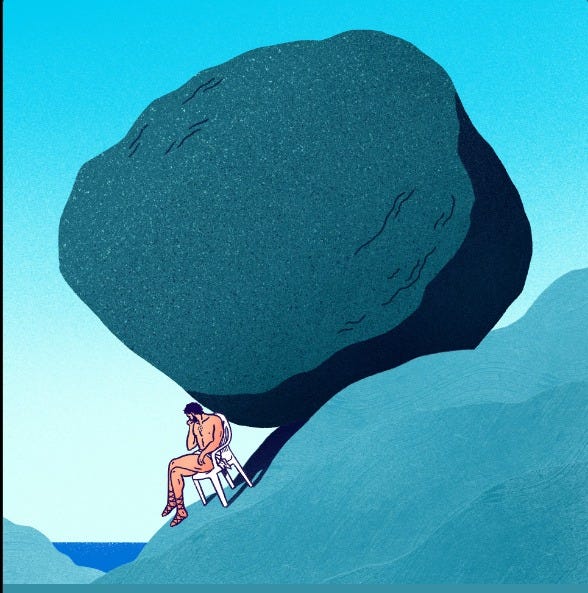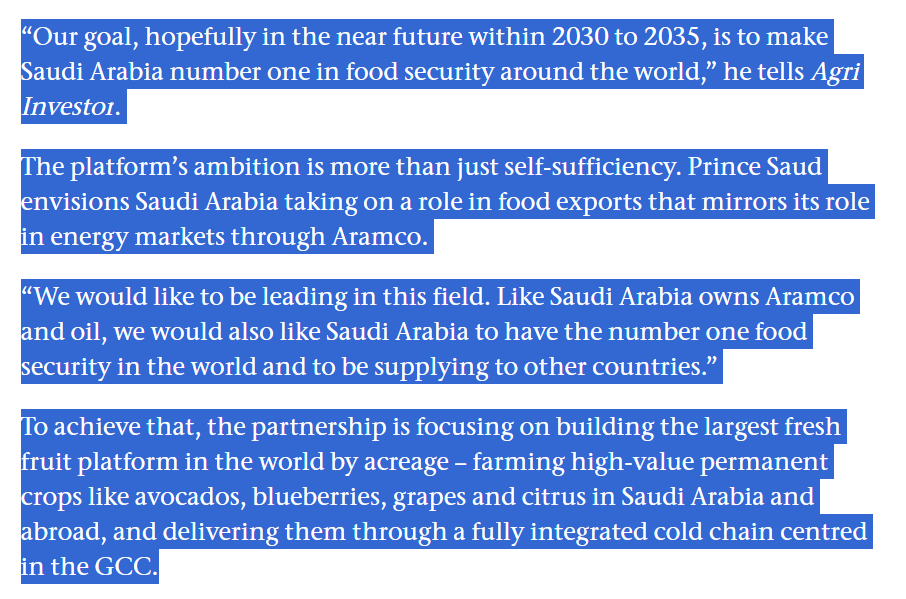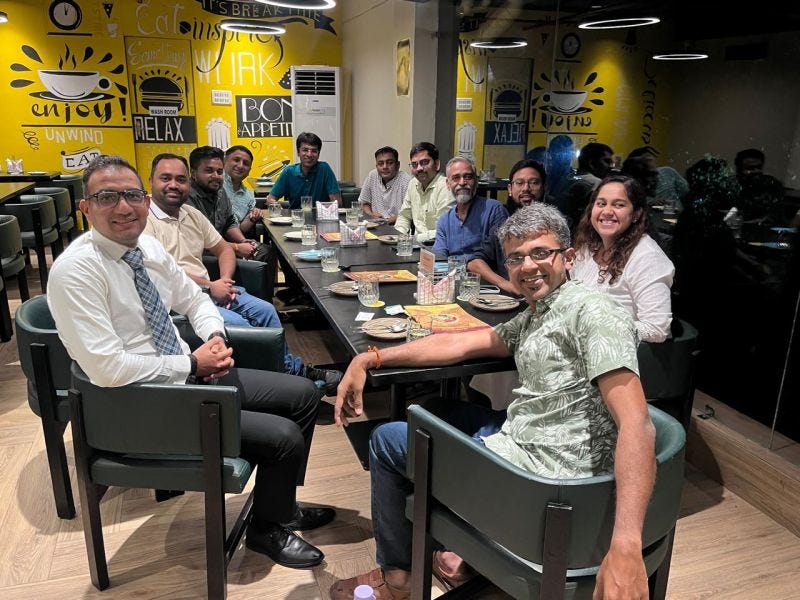
Dear Friends,
Greetings from Hyderabad, India. My name is Venky. Welcome to Sunday Reflections where I reflect on what I’ve written and ask myself, In doing what I am doing, what am I really doing?
Subscriber-Only Plugins
Analyzing UPL Q4 FY 25 Results; UPL’s Open Ag Foundation Launch
FY24 was a bad year for UPL. Revenues were down 20% and EBITDA was down 51%. UPL was eager to get the debt monkey off its back, targeting net debt/EBITDA below 2x by end-FY25.
Leave aside UPL.
For most agrochemical firms, FY 24 was quite a challenging year with geopolitical unrest, destocking in US, Brazil and China oversupply affecting the Indian market. How did UPL navigate FY 25 when overcapacity from China became the new normal?
UPL strongly fired in all three cylinders with 8% growth in revenue; 47% growth in EBITDA and free cash flow generation of $530 million across their four platforms: 1) Global Crop Protection 2) India Crop Protection 3) Seeds Platform 4) Specialty Chemistries Platform.
FY25 guidance: 4-8% revenue growth, at least 50% EBITDA margin growth, $300-400mn operating cash flow for debt reduction.
It’s fascinating to note that with its presence in 140 countries UPL has no customer more than 3% of its revenue. Their working capital days also reduced ‘from 86 days in FY24 to 53 days, a reduction of 33 days resulting in a release of ₹33.7 billion’. The net debt has now been reduced by $1.04 billon.
More analysis on UPL Q4 FY25 Results, Saudi Arabia’s Food Security Goals, State of Agri-Photo Voltaic Wave in a recent subscriber-only edition of Agribusiness Matters.
Desert to Dining Table: Analyzing Saudi Arabia’s Food Security Goals
Saudi Arabia has access to only 1.63% arable land area. They currently imports 85.7% of its food and beverages, with annual food import growth averaging 7.9% since 1990.
Thanks to Ag Investor, I stumbled upon their food security goals. Saudi Arabia wants to build the largest fresh fruit platform in the world by acreage - farming high-value permanent crops like avocados, blueberries, grapes and citrus in Saudi Arabia and abroad.
The underlying assumption here is that farmers need better income to consume and grow high-nutritious foods. If you do a global study of food systems, you would often see this assumption left unquestioned.
Would building the largest fresh fruit platform help them achieve their food security goals?
I address this question and unpack its varied layers in a recent subscriber-only edition of Agribusiness Matters.
The Reports of Food Security Fears Are Greatly Exaggerated
Historically, whether it is Irish Potato famine (1845-1852) or Bengal famine (1943), the problem didn’t lie in crop failures. Both Bengal and Ireland were exporting rice and potatoes during the crisis. Both suffered from colonial regimes that couldn’t care less about the real price of hunger and took callous decisions with gross bureaucratic mismanagement fully knowing the stakes at hand.
“What happened after the famine is revealing. Between 1849-1854, landlords evicted ~50,000 Irish families and transformed their plots into productive cattle farms. This rapid conversion proves the land could support diverse agriculture under different institutional arrangements. The Land Acts (1881, 1903) provide the conclusive evidence. By facilitating tenant ownership, these reforms transferred ~9M acres to former tenants by 1914, fundamentally restructuring Irish agriculture without any significant technological change.
The lesson is clear. Ecological resilience requires appropriate institutional frameworks, not just technological capacity. Ireland's catastrophe stemmed from designed vulnerability, not agricultural limitation - Sam Knowlton
And this pattern more or less continues today with mismanagement and corruption significantly contributing to Japan’s Rice Price crisis (further buttressed by Gintan system, acreage control system) and Philippines’ Food Security Emergency respectively.
“Decades of falling per capita consumption, farmers aging rapidly, no new growers added, planted area dropping, and most importantly the government stored stock in the form of brown rice - while people consume white rice. Processing takes time and free capacity of units, which doesn’t happen instantly just because the government wants it. There is a lead time for delivery. So even though they have ‘buffer stocks’ they can’t intervene in the market effectively immediately.” - During a conversation with an Agripreneur friend on Japan’s Rice Price crisis.
And so the question we ought to think about is this.
How do we accurately model the impact of Climate Change on food systems in our head?
I address this question in a recent subscriber-only edition of Agribusiness Matters.
If you meet an entrepreneur in the road, kill him
Ninth-century Chinese Buddhist monk Linji Yixuan famously told his disciples, “If you meet the Buddha on the road, kill him.”
As I reflect on my five year entrepreneurship journey, one of the key learnings I am now discovering is this: If you meet an entrepreneur on the road, kill him.
Obviously, I am talking about my journey, my learnings and this is not what it seems.
We live in an age of entrepreneurial narrative myth. In feudal countries like India, entrepreneurial energies are powerful when you want to move against the currents and carve your own path. But, once you've carved your path, if you want to walk further, entrepreneurial identity can be a serious bottleneck.
In the nature of my work, the moment I step in outside my entrepreneurial field of energies, incredible things happen.
If I am serious about being entrepreneurial, holding onto the identity of "Entrepreneur" is the worst thing I could do.
If you want to create systemic change at the level of ecosystems, it is important to see like an ecosystem. And be an Ecosystem.
Theory of Constraints states that every system has one bottleneck tighter than others. Which bottleneck affects the design of our lives more than anything else? Your life's highest possibility is always going to be constrained by the identity that you strongly hold on to.
Whatever identity you hold onto tightly if you don't pay attention, it becomes the bottleneck that constrains the design of your life.
To create more powerful ecosystemic possibilities, I am discovering It's time to unlearn the entrepreneurial identity I have. I am not an entrepreneur. I am not a free agent. I am not a musician. I am not a writer. I do few things - I write, I sing, I do gigs, I do crazy experiments in entrepreneurship.
Post Facto: Vishal Jeevan made an interesting comment:
“If you are essential to what you do, you cannot abstain from doing what you are meant to do, that part is identity. If what you are doing is not meant or for whom it is meant, then either one finds a new arena , audience , or a new way of doing it, this part is perspective…
Attaching one’s sense of being to the response of one’s path needs a broader perspective, mainly to overcome friction ( read bottleneck)
You become the path you traverse …”
Why are farmers missing in most of our agriculture/agritech conferences?
Given the nature of my work, I attend many conferences to push status quo across different policy, technology, agripreneur and climate change levers. One thing is common in most of these conferences: Farmers are missing!
Socratus Foundation for Collective Wisdom sometime back organized Janta Ka Faisla where entrepreneurs have to pitch their solutions to a group of farmers. They also organized Budget Charcha (Dialogue) with MPs and farmers and Rural Agenda series.
In the upcoming Agripreneurs retreat in Coimbatore on September 25-26-27, we plan to do it near a famous auction center for garlic and trigger conversations around auctions, marketplaces. Hopefully, we should be able to invite few farmers as well.
Of course, farmers have their work and don't have all the time on earth for many of our silly conversations surrounding farmers and farming. But, I am sure, if we are able to design serious agendas with action bias around farming, farmers would happily turn up.
Given the absence of farmers in the conferences, we waste a lot of time speaking among each other who want the best interest of farmers. We could save a lot of time and energy if we simply have farmers in the room.
Our understanding about their problems could also undergo a rapid 360 degree change if we include them in the room.
Who is designing the next conference with farmers?
Post Facto: Shirish Joshi made an interesting point:
“For examples in doctors conferences are patients present? In architects conferences are residents present?
If farmers need to be present , and in many conferences they are ' brought' to showcase so called ' voices from the ground'.we as Indians are very good in tokenism.
If farmers are customers/ consumers/ beneficiaries of professional discussion their role could be to confirm the need or the problem at hand. They can also comment on suitability of solutions to be discussed. There may be parts of the conferences where they have no role to play.
Farmers is not a homogeneous group. It is necessary to bring relevant farmers.
Lastly a separate language is needed to have conversations with farmers ( who may or may not be familiar with specialised concepts etc).
In short let us not romanticise .”
Notes from Bhopal Agripreneurs Meet
My impact hypothesis - Agritech Ecosystem Engineering -is deeply inspired by Mahatma Gandhi.
The old frail man wrote endlessly. He walked a total of 79,000 km during his political campaigns from 1913 to 1948. His collected writing volumes can easily crawl up a wall. He had letter correspondence with a massive network of people across diverse walks of life across the length and breadth of the country. He kept dialoguing with people whom he met on all topics including health, education, agriculture, politics and every other topic under the sun.
Is it possible to keep writing what is really happening on the ground in agriculture; keep abreast with latest technologies while dialoguing with every serious changemaker working in food and agriculture systems across the country? And is it possible to support and build a vibrant community of Agripreneurs who are aspiring to change the food and agriculture systems in the country?
The ease with which Agripreneur Meetups happen across different cities amazes me. I discover friends I didn't know I had. Prateek Sharma graciously played the host of Bhopal, showed me around the city and brought in his agripreneur friends.
Met Hitesh Warathe, co-founder of Gramya Ventures who is building a sustainable millet value chain. Working with 6 FPOs and 12,500+ tribal farmers in Madhya Pradesh. They support them with quality inputs, value addition, and strong market linkages to improve income and reduce post-harvest losses.
Met my old friend Varun Singh Chauhan who has been running Agromaxx, an agri-input manufacturer building santulan kheti as a midway between organic and conventional agriculture.
Met old friends Prachur Goel and Pramel Kumar Gupta who are building an interesting "unbranding" social enterprise agency called "Momentum Shifts" that aspires to change the narrative of food and agriculture systems among consumers.
Prateek Sharma from Green and Grains is building vegetable D2C while building playbook for how agritech firms can collaborate with government in a win: win arrangement.
Met Yogesh Pund, who is building a creators' playbook for farmers who can become their own brand ambassadors. There are interesting possibilities in helping farmers discover pride in farming and become land stewards.
Also met friends building incubators, funders and technologies for agripreneurs. It is a blessing to build in cities like Bhopal which do not have the startup culture that metropolitan cities have. These founders have to build their own paths and that can lead to surprising discoveries.
Madhya Pradesh- the second largest Indian state- is blessed with natural resources and has incredible potential to become a agrarian powerhouse. Can we make MP be the strongest ally for Viksit Krishi, Viksit Bharat?
Should Farmers Be Entrepreneurs?
I might get lynched among my Agripreneur friends for saying this out loud. But I'll still say. It's a dangerous idea we peddle that farmers have to be entrepreneurs.
Its dangerous because they don't have it in their DNA and if god forbid they take this idea seriously, it shifts their default orientation from being stewards of the land to exploiters of the land. (Does that mean every entrepreneur is exploiter? Not quite. )
Today, when Indian soil SOC levels are at 0.3, we are better off if farmers are given better support systems (which are better designed by Agripreneurs which create win-win arrangement) to be truly farmers.
When we peddle ideas about farmers being business men and entrepreneurs, we are confusing them to be neither better farmers. Nor better entrepreneurs.
Farmers carry cultural memory of having the special privilege they once received being a farmer. In many parts of the country, they still receive the privilege while several other parts of the country have forgotten what it takes to support farmers who do farming.
When farmers discover their true potential, we don’t have to worry about the onset of climate change. Yes, even natural farmers are also facing yield losses, as documented by veteran natural farming legend Subash Sharma ji in his recent Hyderabad talk. But, they can offset this loss with better regenerative practices.
The question Agripreneurs must reflect IMHO: Can we help farmers discover their highest potential and become the best farmers they can be?
Post Facto: Anup Pai made an interesting comment:
“I think the word "entrepreneur" is misunderstood. Madan Padaki's view is that the root for this word is the Indic "Antar Prerna". We definitely need the people tending to land to be driven by love for healthy ecosystems. Building socio-economic ecosystems that provide small holding farmers financial security is the Antar Prerna for proponents of mass entrepreneurship.
Is Food Waste Worth Solving?
Everyone working in the food and agriculture systems think Food Waste is a massive problem worth solving.
But here is the thing.
If you think about it deeply from system lens, you would discover that this is a problem not worth solving. Yes, you heard me right. Not worth solving.
Solving for Food Waste reminds me of the scientist Masanobu Fukuoka talks about in his classic tome, One Straw Revolution:
"It is the same with the scientist. He pores over books night and day, straining his eyes and become nearsighted, and if you wonder what on earth he has been working on all that time - it is to become the inventor of eyeglasses to correct nearsightedness.”
Why do you want to be this scientist solving for food waste ?
Why do you want to solve Food Waste if there is a better way to tackle how we produce food in the first place? Granted. Food Waste sounds sexy and important in the climate scheme of things.
Don’t get me wrong.
Some of you might have raised millions attempting to solve this problem.
But if you are really serious about solving Food Waste, you wouldn’t be solving it where the problem manifests itself. You would be solving it where the problem originates so that you can be done with it once and for all.
Post Facto: This led to lot of interesting conversations in the chatter spaces and Agripreneurs Community
Vivek VS: Food waste is not a cause of food production. It is a consequence of supply chain and produce logistics.
Venky: You cannot decouple production dynamics from supply chain dynamics. Both are interconnected. The latter influences former in terms of varieties selection. And the former influences latter as well
Vivek VS: Try to connect the two has led to us never solving the problem. The demand for production is not consumption based. Mono cropping works because a sizeable share of consumption comes from non-food activities. Hence you see price stability which encourages people to cultivate the crop. On food alone, price hasn’t been stabilised.
Chollin Selvan: This varies across perishables and non-perishables. Perishables - Over Production is the major reason. Non Perishables - Supply Chain, Storage SOP is the concern.
VS Vivek: APMC and their auction process has single handedly kept the farmers in our country poor for decades. Because market or price for them is the nearest big mandi. The only people who benefit from Mandi(s) are the traders who have licenses.
Buyers only buy what is available in the mandi not what they need.
Sreeni Reddy M: While I agree — tackling “food waste” at the end (like retail discard or surplus redistribution) feels like trying to invent glasses for the nearsighted — there is a systems lens required even within post-harvest operations.
1. Pre-harvest: Poor crop planning, skewed market signals, or seed-to-soil mismatch create oversupply or subpar quality right at the farm gate.
2. Post-harvest: The real tragedy is logistical misalignment — lack of real-time demand visibility, grading standards not fit for purpose, or processing infra being too far from source, leading to perishables being dumped, not due to rot but due to misfit.
The opportunity isn’t just to “rescue waste,” but to re-align incentives, infrastructure, and information — and most importantly, shift power back toward growers who grow what we actually consume.
So, what do you think?
How happy are you with today’s edition? I would love to get your candid feedback. Your feedback will be anonymous. Two questions. 1 Minute. Thanks.🙏
💗 If you like “Agribusiness Matters”, please click on Like at the bottom and share it with your friend.




